Research Interests
The dynamics of photoexcited electrons and holes can be measured on the
timescale of ~100fs by using ultrafast optical spectroscopy. The carriers interact
strongly with each other to form a hot plasma, which then cools by interacting with the
lattice. In my experiments I make real-time measurements of fundamental optical properties
such as absorption and luminescence using pulses generated by modelocked lasers. These
measurements are important from a fundamental point of view, since they provide basic
information about electron-electron and electron-phonon interactions, and they are of great
practical significance since the speed of these processes limits the speed ultimately
obtainable in electronic and opto-electronic devices.
My main interests have been in making resonant measurements on wide-bandgap
semiconductors and low-dimensional systems such as quantum wells, wires and dots. Topics
currently being investigated include coherent electron-hole dynamics, excitonic dynamics
in wide band gap materials such as GaN and InGaN, and gain mechanisms in bulk and quantum
well lasers. Please have a look at my publication list for references to relevant recent
work.
I am now involved in a LINK grant with The Department of Materials in Oxford,
Hitachi Cambridge and the Microelectronic Research Centre in Cambridge. The
grant is entitled "Nanoelectronics at the Quantum Edge", I am looking at
InGaN and GaN quantum dots, studying dephasing, carrier lifetime and inter-dot
interactions. For more details see the project website at
www.nanotech.org.
Work on Quantum Dots
Under the LINK grant entitled "Nanoelectronics
at the Quantum Edge" I have been investigating the optical properties of
single quantum dots using micro-photoluminescence CW and time-resolved spectroscopy. The text below
comes from the project web page.
Overview & Relation to
Quantum Computation
Quantum dots are small nanometre sized inclusions of a lower bandgap material
in a solid matrix of higher bandgap. These materials, when excited optically,
show evidence of the "quantum confinement" of electrons and holes in the dot
material. There is currently much activity in the field of quantum dots as there
are many potential applications in optoelectronic devices and other novel
applications. One such application is quantum computation.
In this field, quantum dots are a useful playground for investigation, as it
is possible to grow arrays of quantum dots in vertical stacks with well defined
separations. This is important, as one of the most important aspects of any
quantum logic device will be the ability to control the interactions between
separate qubits. The variation in spacing between dots will change their
interaction strength. However, in order to build a quantum computer there are
many practical difficulties to overcome.
Our Work
Although much previous work has been done in the InAs family of quantum dots,
we are interested in the III-Nitrides. There are reasons for believing that they
may be more promising in the long term for the development of quantum logic
circuits:
The exciton binding energy is high (25meV) so that excitons are stable up to
room temperature.
Quantum dots in the nitride system have strong piezo-electric fields such
that the dots levels can be shifted to both higher and lower energies under the
influence of an applied electric field.
The LO phonon energy is also high (92meV), which suggests that the quantum
dots may be more decoupled from the thermal environment than in other systems.
If this is shown to be the case, it may manifest itself in longer coherence
lifetimes in such dots. The coherence lifetime is a parameter of great
importance, as successful quantum manipulations demand that the wavefunctions
are coherent over the time period of operation and error correction of the
system.
Experimental Methods
Currently we are interested in the characterization of Nitride quantum dots,
in order to measure certain parameters. The experimental tools we have available
include:
A time-correlated single photon counting system.
A micro-photoluminescence measurement system.
A macro-photoluminescence measurement system.
A coherent control system.
A high resolution spectrometer for single dot spectroscopy.

Fig. 1: A schematic of our sample and a method to isolate single dots for
optical measurements. An Aluminium mask is deposited, then windows as small as
100nm x 100nm are etched away, leaving some holes that contain a single dot.
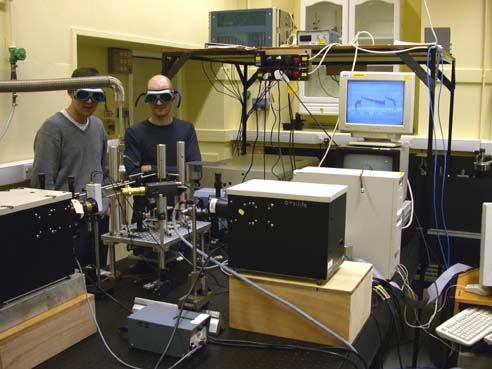
Fig.2 This is a photograph of the micro-PL system that we have
set up in order to look at the time- and spectrally-resolved emission from a
single quantum dot.

Fig 3. Decay of a single InGaN quantum dot at 4.2K
People
Our work is based in the Clarendon Laboratory, at the Department of Physics
in the University of Oxford. We are also collaborate with colleagues in the
Department of Materials in Oxford, as well as with Cambridge University
Microelectronics Group and Hitachi in a LINK project aimed at the development of
a solid state quantum computer. The people working directly in the field of
Nitride dots are:
Dr Robert Taylor - has a
great deal of experience in optical measurements of GaN and related materials.
Past research has included work on ultrafast carrier relaxation, gain
mechanisms, plasma effects and the Mott transition in both bulk and quantum well
materials.
Dr James Rice is a postdoctoral researcher, with experience of ultrafast
measurements on zero-dimensional materials such as fullerenes and dots.
Jonathan Smith is a 3rd year
DPhil student. He has been working on time-resolved investigations in bulk,
quantum wells and recently GaN quantum dot materials.
Rachel Oliver is a 3rd year DPhil student in the Department of Materials
working on the development on S-K growth of InGaN quantum dots.
James Robinson is a 1st year DPhil student investigating GaN quantum dots.
Anas Jarjour is a visiting student from ENS Paris, investigating GaN quantum
dots.
Work on bulk GaN
Some years ago I began a project at the CLRC in the Rutherford
Appleton Laboratory near Didcot in Oxfordshire. There I used their
amplified femtosecond Ti:sapphire laser system to excite epilayers of GaN. This
was achieved by frequency shifting the 800nm Ti:sapphire beam in an optical
parametric amplifier to wavelengths resonant with, and shorter than the bandgap
of GaN. This meant that both hot-carrier dynamics and cold exciton dynamics
could
be studied. The technique used was time-resolved reflectance or absorption
spectroscopy. Here the sample was excited using an ultrafast laser pulse (250fs)
and probed at various time delays after excitation by a white light continuum
generated by focusing some of the amplified laser light into a transparent
non-linear medium such as water of sapphire. This continuum had a duration of
800fs when generated in water, and 250fs when generated in sapphire. A detailed
description of the experiments and results can be found in my recent
publications, some of which are available as .PDF files at this Web site.
Recently the Department of Physics here in Oxford purchased a Ti:sapphire
amplifier system with a dedicated optical parametic amplifier (OPA) from Spectra
Physics. This consists of a MaiTai oscillator and an Evolution pump laser boxed
in a system known as a Hurricane. This is capable of producing 125fs pulses at a
repetition frequency of 1kHz with pulse energies of up to 0.9mJ. The output from
the amplifier can be shifted to cover most of the near-UV, visible and near-IR
using the OPA. We are currently using the system in conjunction with a
femtosecond Kerr gate to investigate time-resolved emission dynamics from InGaN
MQWs with sub-picosecond time resolution.
I have included some photographs of the experimental system,
both at RAL and in the Clarendon
(and some dedicated researchers!) below.
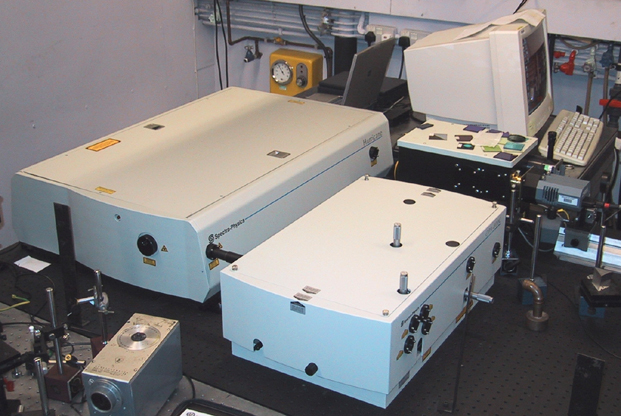
Above are pictured a Spectra Physics Hurricane Ti:sapphire amplifier pumping
an optical parametric amplifier (OPA). The OPA output at 1.36mm
is frequency-doubled twice to produce 125fs long pulses at a repetition
frequency of 1kHz with energies of ~1mJ at 340nm.
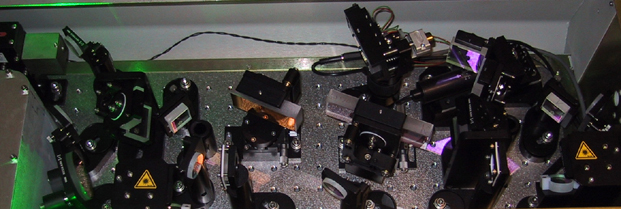
This photograph shows part of the inside of the Hurricane. Here we see the
gratings used to stretch the pulses before amplification, and to recompress them
afterwards.
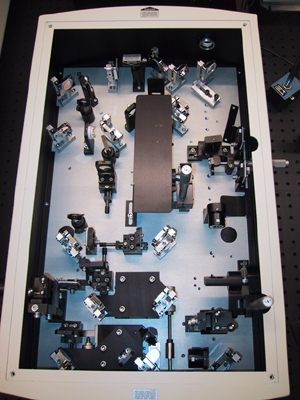
The inside of the OPA is pictured above. Some of the 800nm light from the
Ti:sapphire amplifier is used to create a white-light continuum. This is used to
seed the OPA, where the pulses are split up spectrally such that the sum of the
frequencies of the two parametric beams equals the frequency of the input beam.
The amplified output is then passed through two doubling crystals to shift the
wavelength into the UV.
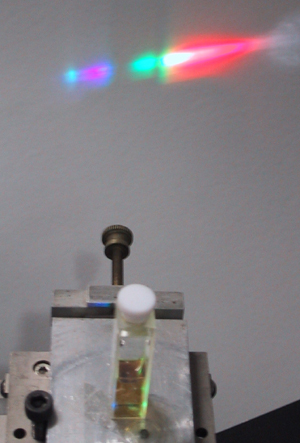
Femtosecond white-light continuum pulses generated by focussing some of the
amplified beam into a disc of sapphire are passed through a cell containing the
dye Coumarin 102. As can be seen on the screen, the dispersed continuum light
has a missing region in the blue, where it has been absorbed by the dye.
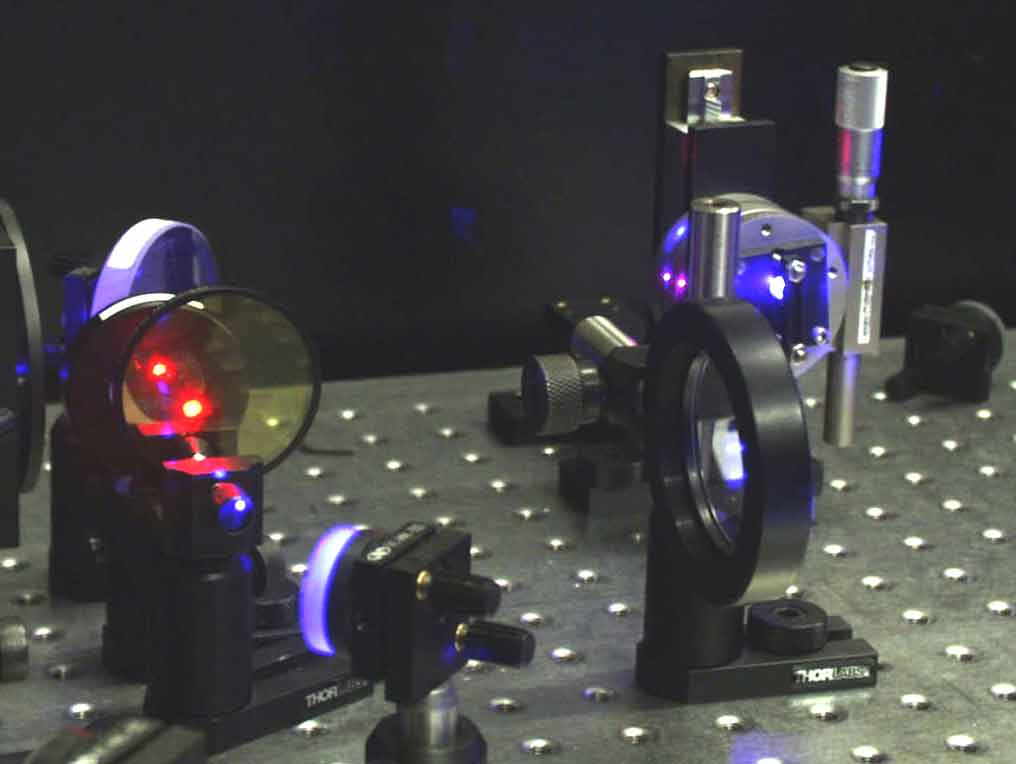
This photograph shows an optical parametric amplifier (OPA). The fundamental
800nm light from the Ti:sapphire laser is first frequency doubled, then focused
into the non-linear crystal seen above. The 400nm photons are split in two to
form a red beam (seen above) and an infrared beam (known as signal and idler).
The red light at ~640nm is mixed with residual amplified 800nm light to produce
a pump beam at ~355nm. The pump wavelength can be tuned by rotating the
non-linear OPA crystal.
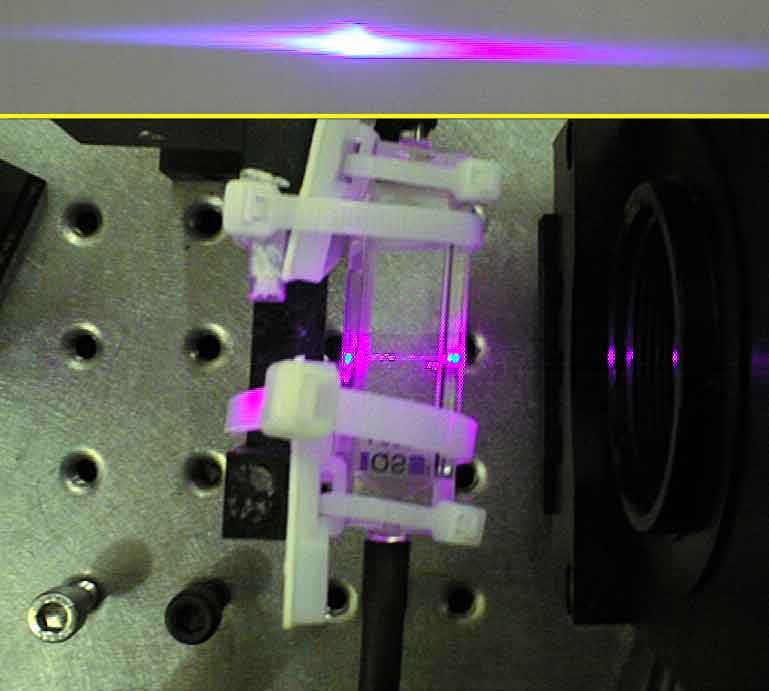
In the top section of this photograph a white light continuum centred at
400nm is shown. The photograph was taken by dispersing the white light continuum
generated by focusing the laser beam into a cell of D2O (shown in lower
portion of photograph) using a diffraction grating.
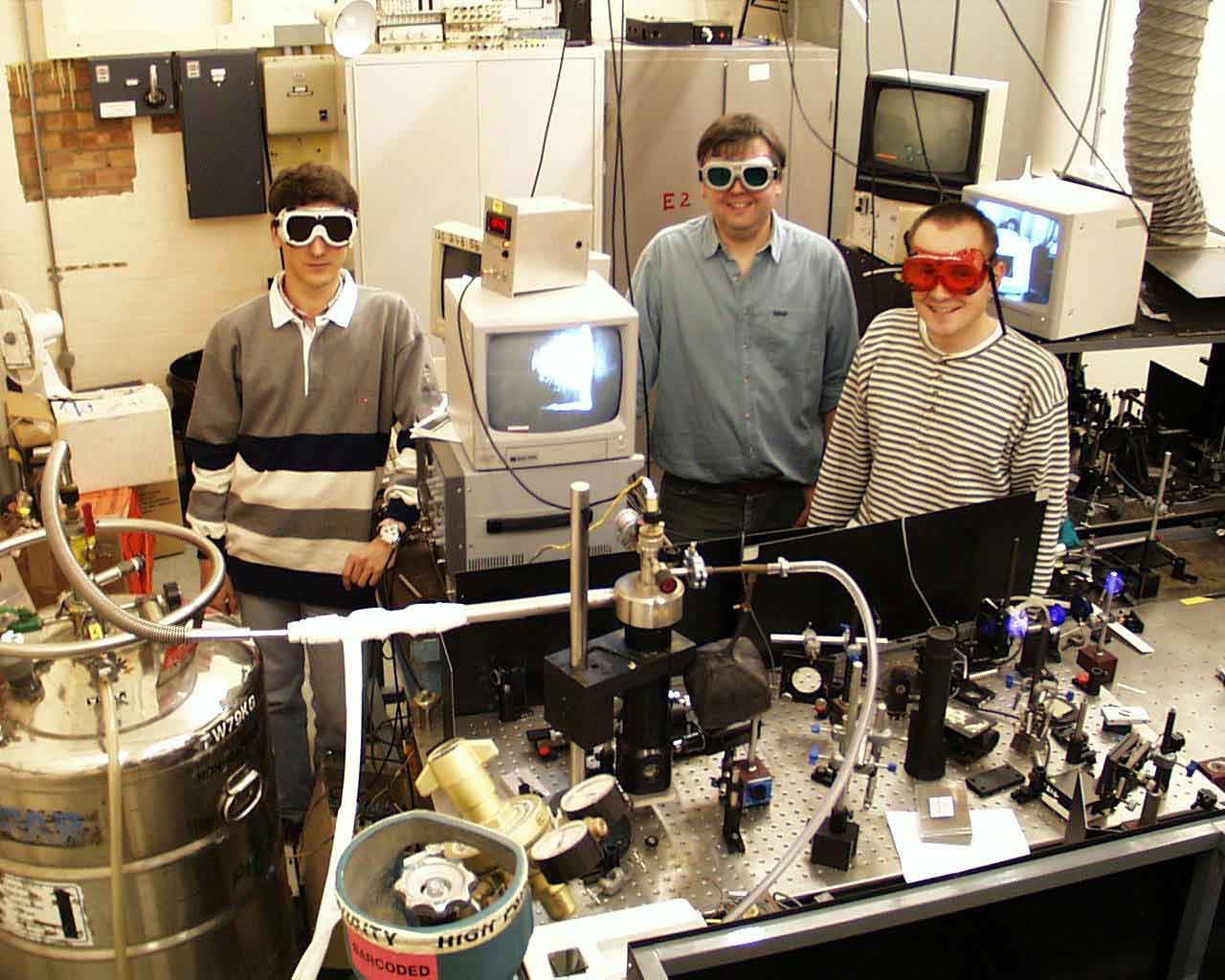
Here we see the experimental system. The GaN sample sits in a continuous flow
liquid helium cryostat, capable of maintaining the sample at temperatures
between 4K and room temperature. Also shown in the picture are Stefan Hess - my
graduate student (now has his D.Phil. and is working for Corning Glass in
France), Francois Walraet - a project student from Paris, and of course, me!
Back to my home page









